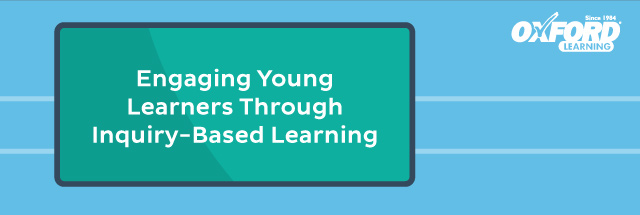Engaging Young Learners Through Inquiry-Based Learning

Every educator has struggled with the challenge of keeping their students engaged and interested in their learning material. One way to overcome this hurdle is to embrace inquiry-based learning — a teaching method that places students’ questions, ideas and observations at the centre of the education experience.
At one point or another, every educator has struggled with the challenge of keeping the attention span of a classroom full of students. When students do not find subjects or problems particularly interesting or intellectually stimulating, they often have difficulty staying focused and have issues with retaining important information.
One way to overcome this hurdle — and to foster a greater interest in the material being taught — is to encourage students to become active contributors to their own learning experience through a method of teaching known as inquiry-based learning.
What is inquiry-based learning?
In the Ontario Ministry of Education’s report Inquiry-based Learning: On Transforming Wonder into Knowledge, inquiry-based learning is described as a teaching approach that builds on the idea that educators and students both share responsibility for learning.
Instead of an educator telling students everything they need to know, inquiry-based learning places students’ questions, ideas and observations at the centre of the learning experience, and requires them to engage in evidence-based reasoning and creative problem solving. The approach emphasizes learning by doing, encouraging students to build their knowledge through experience and exploration.
![]() Inquiry-based learning places students’ questions, ideas and observations at the centre of the learning experience [Tweet This]
Inquiry-based learning places students’ questions, ideas and observations at the centre of the learning experience [Tweet This]
“The key to [inquiry-based learning] is to teach students how to ask their own questions, and to discern good questions from bad questions,” explained Dr. Alan Edmunds, Associate Professor in the Faculty of Education at Western University.
Dr. Edmunds added that the approach is about helping students generate solid, inquisitive and deep questions around a topic.
Inquiry-based learning also combines several approaches to instruction that have been proven to be successful, including small-group and guided learning.
According to Dr. Sharon Friesen, Professor and Vice Dean of the Werklund School of Education at the University of Calgary, inquiry-based learning has been used in the classroom environment at universities since their inception. She explained that this form of teaching has also been used in primary and secondary education for decades.
“K-12 classrooms are set up to support inquiry work. They actually have been for quite some time, as inquiry-based learning first made its way into K-12 classrooms in the late 1920s and early 1930s,” Dr. Friesen said.
What components are needed to make inquiry-based learning work?
While inquiry-based learning is a dynamic approach that can be adapted for almost any learning environment, there are several components that need to be put in place in order to make the teaching style successful for everyone involved. A few of these key components are:
A culture of inquiry: According to Inquiry-based Learning: On Transforming Wonder into Knowledge, establishing a culture in which students are encouraged to express their thoughts and challenge one another’s ideas is an important first step in the inquiry process. When students feel comfortable and encouraged to share what they are thinking, they are much more likely to contribute to a classroom discussion amongst their peers.
External support (for teachers): Dr. Friesen explained that unless a curriculum has been designed to require deep understanding of a few significant ideas central to the subject disciplines under study, teachers would need to spend a significant amount of time interpreting and reconfiguring the guidelines to make them coherent and applicable to the inquiry-based learning approach.
Educator guidance and support (for students): Even though a large component of inquiry-based learning revolves around students, the success of the approach depends on the guidance provided by teachers. According to the Canadian Education Association’s research resource Is Inquiry-Based Learning Effective?, “teachers should guide students to develop a good question for investigation, monitor their inquiry process, and provide guidance when they encounter difficulties.” Dr. Edmunds agreed with this, explaining that while students learn great from other students, the teacher needs to guide them so they discover the proper knowledge.
Understanding of the audience: Dr. Edmunds suggested that educators do a small test of their students’ understanding by going through the nuts and bolts of the material prior to asking them higher order questions. He explained progressive assessments should be used to ensure that all students have a solid knowledge base before beginning.
Open-mindedness and spontaneity: When planning for a lesson, teachers may feel the need to begin or frame the discussion around one question or a specific set of questions. However, inquiry-based learning is most effective when the leader has an open-minded approach and is willing to build on spontaneous questions that encourage further thought and discussion amongst the class.
Why is inquiry-based learning important?
Inquiry-based learning is a useful method that educators should embrace, as it helps to enhance the learning experience of students. The method gives children the opportunity to take a hands-on approach in their education while obtaining several important skills that can be used at all levels of their learning, and even into their future careers.
“Within discipline-based inquiry learning, students learn how to: gather, critique, analyze and interpret information; create working theories; pose new questions; bring forward evidence; integrate new ideas,” Dr. Friesen said.
“Students are taught specific skills and knowledge that are at the heart of the disciplines in a discipline-based inquiry-learning classroom as they are key to them fully advancing within the subjects,” She added.
Inquiry-based learning also gives students the opportunity to develop stronger relationships with their classmates, improve their communication skills, and increase the confidence they have in their own ideas and ability to contribute in the classroom.
When Should Inquiry Based Learning Be Used?
While inquiry-based learning is an effective method that can be embraced in a variety of situations, it isn’t a method that should be used for everything.
There are multiple learning situations and lessons that would benefit from a more direct approach, such as explaining how to complete a straightforward multiplication or division equation. Asking higher order questions in a situation like this would likely confuse students, especially if they do not already have the proper knowledge base to take part in the discussion.
However, if an opportunity arises to engage students by asking questions and encouraging them to play a bigger role in their knowledge development, embracing inquiry-based learning will help engage young learners and foster excitement in the subjects they are learning about.
![]() Inquiry-based learning will help engage young learners and foster excitement in the subjects they are learning about [Tweet This]
Inquiry-based learning will help engage young learners and foster excitement in the subjects they are learning about [Tweet This]





